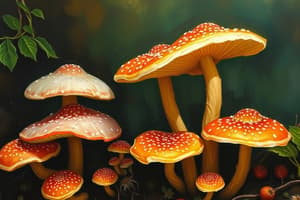Podcast
Questions and Answers
What is the major test used when dermatophytosis is suspected?
What is the major test used when dermatophytosis is suspected?
- Culture in Luria-Bertani agar
- Culture in Sabouraud’s glucose agar (correct)
- Urine test for fungal presence
- Blood test for glucose levels
Which treatment is recommended for tinea superficialis in hairy areas?
Which treatment is recommended for tinea superficialis in hairy areas?
- Systemic penicillin
- Topical application of antifungal agents such as imidazole
- Intramuscular corticosteroids
- Systemic itraconazole (correct)
What is no longer commonly used in Japan for treating dermatophytosis?
What is no longer commonly used in Japan for treating dermatophytosis?
- Terbinafine hydrochloride
- Itraconazole
- Miconazole
- Griseofulvin (correct)
Which test involves morphological observation of conidium by slide culture?
Which test involves morphological observation of conidium by slide culture?
For which type of tinea infection are systemic itraconazole and terbinafine hydrochloride recommended?
For which type of tinea infection are systemic itraconazole and terbinafine hydrochloride recommended?
What is a characteristic of fungi?
What is a characteristic of fungi?
Where do dermatophytes commonly infect in the human body?
Where do dermatophytes commonly infect in the human body?
What type of fungal infection involves parasitization of the dermis and deeper layers?
What type of fungal infection involves parasitization of the dermis and deeper layers?
How is the diagnosis of dermatophytosis confirmed?
How is the diagnosis of dermatophytosis confirmed?
What makes rapid microscopic examination of dermatophytes possible?
What makes rapid microscopic examination of dermatophytes possible?
Which of the following is NOT true about dermatophytes?
Which of the following is NOT true about dermatophytes?
Study Notes
Diagnostic Tests and Treatment for Dermatophytosis
- KOH Preparation: Major test used when dermatophytosis is suspected, allowing for the visualization of fungal elements.
- Tinea Superficialis Treatment: Recommended treatment for tinea superficialis in hairy areas includes topical antifungals like clotrimazole or miconazole.
- Outdated Treatment in Japan: Griseofulvin is no longer commonly used for treating dermatophytosis in Japan.
Fungal Infections Overview
- Slide Culture Test: Test involving morphological observation of conidia to identify dermatophytes via a slide culture method.
- Recommended Systemic Treatments: Systemic itraconazole and terbinafine hydrochloride are recommended for treating tinea corporis and other widespread dermatophyte infections.
General Characteristics of Dermatophytes
- Fungal Characteristics: Fungi are characterized by their ability to be saprophytic or parasitic, commonly forming filamentous structures (hyphae).
- Common Infection Sites: Dermatophytes typically infect keratin-rich areas such as skin, hair, and nails due to their affinity for keratin.
Pathogenesis and Diagnosis
- Fungal Infection Depth: Dermatophytes can cause infection involving parasitization of the dermis and deeper layers, such as in cases of tinea corporis or tinea capitis.
- Diagnosis Confirmation: Diagnosis of dermatophytosis is confirmed via culture and identification of the causal organism or through KOH preparation showing hyphae and spores.
Microscopic Examination and Misconceptions
- Rapid Microscopic Examination: Possible due to the unique morphological features of dermatophytes which can be observed after KOH treatment.
- Misconception About Dermatophytes: Not all dermatophytes are capable of causing infections in every individual; susceptibility varies based on immune response and environmental conditions.
Studying That Suits You
Use AI to generate personalized quizzes and flashcards to suit your learning preferences.
Description
Explore the characteristics of fungal infections, including dermatophytosis and deep fungal infections. Learn about the parasitic nature of fungi in different tissue layers and their classification into genera. Understand the impact of dermatophytes on the skin and nails.




